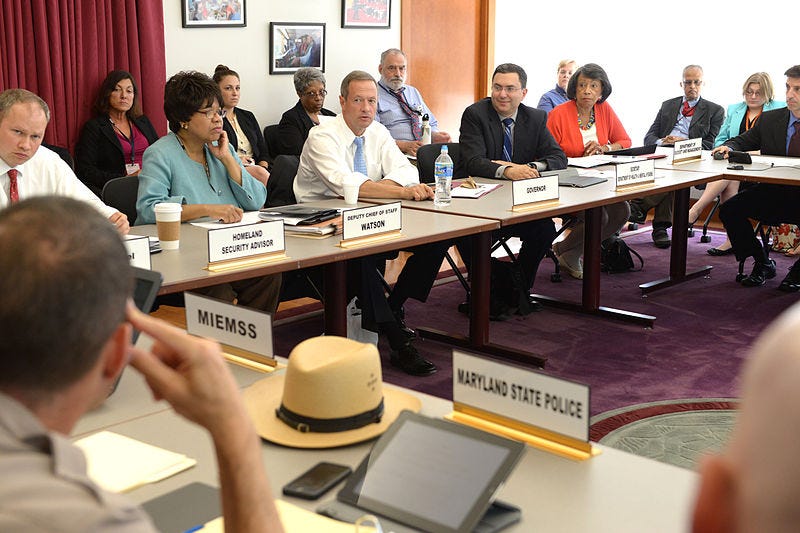Global Shield Newsletter (11 October 2023)
Enabling great power cooperation, building democratic resilience, and learning lessons from a global pandemic
This twice-monthly newsletter highlights the latest policy, research and news on global catastrophic risk (GCR).
In this edition, we reflect on how geopolitical and political dynamics shape global catastrophic risk. Governments, whether democratic or otherwise, will need to cooperate to reduce GCR. Meanwhile, they need to take domestic measures to shore up resilience of their governance. COVID-19 serves as a global learning exercise.
Enabling great power cooperation, not competition
Global Policy journal has published a special tribute to Dr. Nathan Alexander Sears. A young and accomplished GCR researcher, he passed away tragically in March 2023. Nathan focused on the intersection of international relations and GCR, particularly the role of great powers. In the edition, Haydn Belfield paints a picture of Nathan’s work, his intellectual curiosities and what he meant to the field. Scott Janzwood describes Nathan the man and the academic. Michael Lawrence looks at Nathan’s work on great power rivalry and GCR, the subject of his PhD and final presentation. Tom Hobson and Olaf Corry dissect Nathan’s concept of existential security, “one of the first efforts to systematically think through security and how it might relate to thinking about existential risks.”
Global Shield echoes these sentiments and pays tribute to Dr. Sears.
Policy comment: Building upon his work, international relations (IR) must increasingly grapple with GCR. Relations between states directly contribute to great power conflict, the production and use of weapons of mass destruction, climate change and AI risk. It will also be critical to preventing and preparing for GCR. Should a catastrophe occur, IR will shape the response. However, as Nathan’s pioneering work showed, IR as an academic field, and foreign policy as an arm of government, has no meaningful conception of existential and global catastrophic risk. Security is viewed as primarily a national objective, not a global one. So nation states take measures that seek to increase their own security at the expense of global security – ironically, also, their own long-term security.
A major implication of Nathan’s research is that great powers are more likely to consider existential threats as a problem when they are framed as catastrophic within a national context, when leaders believe the threats to be credible, and when they do not perceive other great powers as hostile. Unfortunately, the current geopolitical landscape is not conducive to this outcome. Strategic rivalry – particularly between the US, Russia and China – is rife. Viewing GCR through an IR focus requires increasing the awareness and perception of threat domestically, while building channels for communication, collaboration and crisis management between the major powers.
See also:
Efforts continue to re-establish high-level diplomatic engagement between the US and China, which has been fragile and heated. The two presidents are potentially meeting on the sidelines of the APEC Summit in November. Meanwhile, a bipartisan group of US senators, led by Senate Majority Leader Chuck Schumer, met President Xi Jinping in China this week. In Foreign Affairs, Michael Beckley argues that, although “neither country wants war, runaway climate change, pandemics, or a global depression”, in reality, “mutual vulnerability may be exacerbating the rivalry”.
Building democratic resilience for GCR
Dangerous and powerful artificial intelligences that would execute harmful goals could be a threat to democracy and human rights, according to Yoshua Bengio in a new paper in the Journal of Democracy. Governments could use powerful AI tools to strengthen their hold on power through surveillance methods as well as control mechanisms such as AI-driven policing.
Epistemic uncertainty – when people cannot tell whether what they see, read or hear is reliable – is an amplifier of GCR, according to a conference paper presented by Elizabeth Seger. Past work by the Open Nuclear Network and others have highlighted how this risk cuts across major global catastrophic threat areas, including nuclear escalation and global conflict.
Totalitarianism is a risk factor for GCR by contributing to other threats, such as great power conflict, or by increasing vulnerability to them, such as climate change, according to a book that connects peace and conflict studies with existential risk.
Policy comment: The political system and the model of governance can shape how GCR is handled. The governance model changes how policymakers might consider the risk, how they develop and implement policy, which groups they consider in this process, how they interact with other countries, and how they engage their citizens. In general, policymakers have a propensity for political short-termism. This bias occurs for a range of reasons, including the electoral pressure, media cycles, lobbying pressure, lack of incentives to plan long term, and the natural human inclination to deprioritize uncertain, unlikely or future challenges. These forces will make reducing GCR difficult.
At the same time, GCR itself will shape political and governance systems. Powerful technologies, such as AI, and catastrophic events could enable governments to centralize power. Totalitarian states, in particular, could use these capabilities and opportunities to reduce human rights and disempower citizens. Should they act globally, totalitarianism could itself represent a globally catastrophic scenario. Even if their capability does not reach globally, undemocratic states might be less inclined to collectively reduce GCR.
Democratic resilience could be an important policy area for treating all-hazard GCR. Democratic systems, as well as governance systems more broadly, need to withstand and recover from extreme stresses and shocks. Improving political stability – such as by strengthening democratic institutions and increasing electoral integrity – would reduce disruptive and distracting political turmoil. Legislative and policy mechanisms for long-term issues could enable more considered approaches to GCR. Improve transparency and accountability of policymakers would improve trust in government. And increasing the epistemic environment – by safeguarding the digital landscape from cyber-attacks, combating misinformation while maintaining civil liberties, and improving media literacy – empowers citizens and allows for more common knowledge. Resilience of governance is resilience of nations.
Learning all-hazard lessons from a global pandemic
Foreign Policy magazine recently organized a tabletop exercise with experts from government, academia, think tanks and the private sector to wargame a hypothetical bioterrorist attack in Europe. Dan Mahaffe, Director of Policy for the Center for the Study of the Presidency & Congress, describes the lessons from the exercise. The key conclusion is that the world continues to lack biosecurity preparedness.
Katalin Karikó and Drew Weissman were awarded the Nobel Prize for Medicine for discoveries that led to the development of mRNA vaccinations. This was fundamental to rapid responses to the COVID-19 pandemic. Notably, earlier in her career, Karikó had major issues conducting research, finding support, receiving grants and owning patents relating to her work because of, what Vox calls, a “broken academic science system.”
Policy comment: Like many threats, pandemic prevention and preparedness requires threat-specific policy approaches, including biosafety protocols, disease monitoring and detection systems, incident reporting and investigation, vaccine development and infrastructure for air and water monitoring and quality. Still, the key lessons from these experiences relate to all global catastrophic threats. Many of the solutions that would reduce pandemic risk could reduce GCR in general, and ensures governments do not simply ‘fight the last war’:
Emergency management services, hospitals, and healthcare systems should be capable and flexible across various catastrophic scenarios.
Identifying and tracking potentially malicious actors would be relevant to engineered pathogens as well as harmful use of AI and other technological system.
Supply chain resilience will be disrupted by pandemics, as well as by natural disasters, critical infrastructure failures and conflict scenarios.
Coordination and cooperation are required between governments, at the leader level and at the bureaucratic level.
Governments can build domestic supplies and strategic stockpiles of critical goods, such as food, fuel and medical supplies.
Risk communication efforts, both prior to and during a crisis, could be built for all-hazard risk, with tailored messaging for specific hazards.
Governments should be ready and able to surge production capacity in the private sector.
Scientific capability, within the government and within academic communities, is important for risk monitoring as well as innovative risk interventions.





